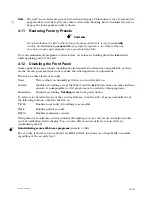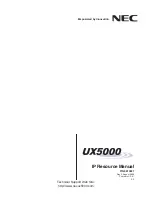
6-1
Rev 2.2, 10/31/94
6. Fast First Time Setup
Follow these instructions to get your 601 up-and-running as quickly as possible. The intent of
this section is to get the 601 to pass signal. If you need something clarified, you'll find the
answer elsewhere in this manual.
Figure 6-1 is a simplified block diagram of the 601. Take a moment now, check the block
diagram out, and take note of the following points:
❏
The diagram shows three different signals: mono, stereo, and data. Stereo signals only
exist in the digital
domain.
❏
All input signals are
treated as a stereo pair;
any processing applied
applies equally to both
channels.
❏
Mic or line signals are
converted to digital and
applied equally to the
left and right digital
inputs of the DSP chain.
❏
Stereo signals applied
via the digital inputs
remain stereo.
❏
Mono signals applied via the analog inputs can emerge from one or both outputs (if you
use the delay with some difference in the delay times, you can "stereoize" the output).
6.1 Connections
Connect your analog input source to the appropriate XLR connector. The microphone input is
intended for low-impedance, balanced output, dynamic, ribbon, or condenser microphones.
48V phantom powering may be enabled via the rear-panel switch. The line input is intended for
balanced or unbalanced line level inputs with signal levels between -10 and +4 dBu. Connect
the 601's analog outputs to your console's line inputs using the XLR, connectors.
The digital input/output connectors are intended for sources or loads conforming to the
S/PDIF or AES/EBU digital interface standards. The 601's digital input accepts any word
length up to 24-bits.
The analog and digital inputs and outputs may be used in any combination (i.e. analog in -
analog out, analog in - digital out, digital in - digital out, digital in - analog out.) The 601
operates at either 44.1 kHz or 48.0 kHz sample rates (input and output are always the same
rate).
If you are using the 601's analog inputs with the digital outputs, you can supply an external
sample-rate reference signal via the S/PDIF or AES/EBU digital input. This may be useful in
situations using a single master clock source. Designate the digital input as the clock source
via the
G
LOBAL
parameter switch, parameter
CLCE
.
If you are using the analog outputs, connect them to your console's balanced line inputs. If you
are driving an unbalanced input, pin 3 of the XLR connector should float. If your audio system
uses pin 3 of the XLR connector as the "hot" connection, then pin 2 of the XLR connector
must
float. This is described in greater detail in Chapter 3.
AES/EBU
MIDI
S/PDIF
FRONT
PANEL
LINE
MIC
D
ATA
BUSS
DIGITAL
INPUT
INPUT
SWITCH
DIGITAL
OUTPUTS
AES/EBU
LEFT
S/PDIF
RIGHT
Rev-A
STEREO SIGNALS
MONO SIGNALS
CONTROL DATA
ANALOG
OUTPUTS
MIC/LINE
SWITCH
A/D
CONVERTER
D/A
CONVERTER
DIGITAL
SIGNAL
PROCESSOR
(D.S.P.)
COMMAND
MICRO-
PROCESSOR
Figure 6-1. Simplified block diagram
Содержание 601
Страница 46: ...4 18 Rev 2 2 10 31 94 This page is blank believe it or not ...
Страница 48: ...4 20 Rev 2 2 10 31 94 Notes ...
Страница 50: ...5 2 Rev 2 2 10 31 94 Notes ...
Страница 70: ...7 16 Rev 2 2 10 31 94 Notes ...
Страница 72: ...8 2 Rev 2 2 10 31 94 Notes ...
Страница 74: ...9 2 Rev 2 2 10 31 94 Notes ...
Страница 78: ...11 2 Rev 2 2 10 31 94 Notes ...
Страница 126: ...D 12 Rev 2 2 10 31 94 Notes ...
Страница 138: ...G 8 Rev 2 2 10 31 94 Notes ...
















































